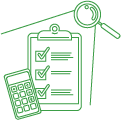When COVID hit, how prepared was your business?
If your first instinct is to reply, “Not very!” – you’re not alone.
While the events of 2020 and now 2021 are well beyond what even the most organised business owner could have anticipated , you might be surprised by how few businesses are prepared for any level of disruption (let alone a global health crisis).
, you might be surprised by how few businesses are prepared for any level of disruption (let alone a global health crisis).
Yet, planning for times of crisis is a key element to success. Setbacks are a natural part of running any business, and the better prepared your business is to respond, the greater the chance of emerging triumphant.
As a business advisory team within one of Australia’s most established accounting and consulting firms, we’ve been at the forefront of helping our clients safeguard their businesses during COVID.
Lost sales, lack of inventory, and difficulty retaining staff are 3 primary issues we’ve seen throughout the pandemic. Agile businesses which were able to pivot quickly, and engage positively with employees and customers, have been the most successful in weathering the storm.
Whether your business is tracking well or teetering on the brink of insolvency, it’s never too late to take stock and evaluate how you may do things differently in the future.
With this in mind, we have developed the 4 stages to consider in preparing your business for any crisis which can form part of your own Business Readiness Plan.
Find out about stage 1: Practical pre-disaster planning below and keep your eyes peeled as we release the rest of the stages.
Stage 1: Practical pre-disaster planning
Most people will agree that, in hindsight, the best time to plan is when everything is going well!
While there may be a tendency for many business owners to “go with the flow” and focus on driving sales, this very often proves short-sighted. As a leader in your business, you should be looking at your business from atop and considering all aspects.
At a minimum, you will want to ensure that your business is always practising good financial hygiene. This means:
 knowing your numbers through regular management reporting
knowing your numbers through regular management reporting- understanding your cashflow
- setting realistic targets
- budgeting
- forecasting
These simple activities are not just important for business readiness, but can also have a major impact on everyday profitability. “The numbers don’t lie” and you may find yourself identifying margin issues, cost blowouts. At the very least, you will set yourself a good baseline to compare to as the “normal course of business”.
In addition to ongoing financial hygiene practices, you’ll want to set aside time each year for forward planning. This could include quarterly sessions to review numbers and the current state of the market, with bi-annual strategy sessions to consider your preparedness across the next 1 to 3 years.
Long-term preparedness entails evaluating the structure of your business and whether it will support you in achieving long-term goals.
It also involves planning ahead for future stress test scenarios which impact the business decisions you make when everything is going well.
For example, it may be tempting to lock in a contract where you secure all your stock through an overseas wholesaler at a 30% discount. But this also presents significant risks if a potential scenario arises where supply chains are disrupted. In this case, negotiating a new deal to secure 70% of your stock requirements through the overseas wholesaler, and 30% through a local provider, helps to safeguard supply in the event of a crisis.
But this also presents significant risks if a potential scenario arises where supply chains are disrupted. In this case, negotiating a new deal to secure 70% of your stock requirements through the overseas wholesaler, and 30% through a local provider, helps to safeguard supply in the event of a crisis.
Another way that we saw forward-thinking strategies play out during COVID was in relation to technology. Businesses that had already surveyed the landscape and begun their digital transformation well before 2020 were well placed to transition immediately to remote working. In addition to business continuity, it meant they weren’t saddled with the cost of implementing new tech at a time when cash flow was tight.
When it comes to staff, proper preparedness planning involves understanding the criticality of each role at any point in time. This way, you can make fast and confident decisions about relocations or redundancies if it becomes necessary in the future.
Preparedness is never a set-and-forget activity. While a business plan might find its way to the back of a filing cabinet, every leader can develop a habit of constantly scanning their business and the landscape it operates in, to consider opportunities and how they will respond to potential threats.
Getting help in stage 1: This is the time when it makes most sense to partner with a business advisor. Choose someone you can trust, and engage them to help you establish good financial practices in the business. An experienced advisor will likely have experience working with similar businesses and will be able to benchmark your performance against competitors.
Click here to read Stage two
Click here to read stage three
click here to read stage four
For more information, contact our business advisory team here
